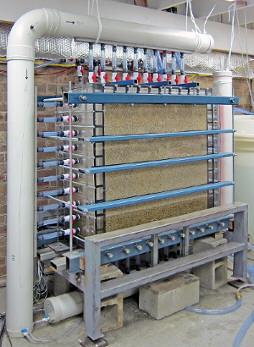Posted 15 June 2012

Advanced hydraulic testing facility located at the Water Research Laboratory in Manly Vale.
An advanced experimental facility designed to simulate natural streambed conditions in the laboratory has confirmed how temperature measurements can be used to study an important pathway between surface water and groundwater.
Sustainable water management must consider surface water and groundwater as a single resource. This requires detailed knowledge of hydrologic processes such as the interactions between surface water and groundwater. The reliable quantification of water flow between aquifers and rivers remains a major challenge.
Natural heat has been used to trace water flow through shallow hydrologic systems such as streambed sediments which form the boundary between aquifers and surface waters.
For example, the effects of daily temperature fluctuations on the substrate beneath surface water are dampened and delayed over depth. The degree to which this happens is affected by vertical flow of water.
This means the velocity of water flow can be derived from continuous temperature measurements at different depths. However, this heat tracing technique relies upon a number of simplifying assumptions not often found in the field.
So far the validity of these assumptions has tested mainly by modelling studies, rather than empirical analysis by experimentation.
As part of his PhD research Dr Gabriel Rau and his supervisors Martin S. Andersen and Ian Acworth designed and built an experimental hydraulic facility simulating a slice of a streambed to investigate the validity of some of these assumptions.
Designed for conducting solute and heat transport experiments through any type of sediments under controlled hydraulic and thermal conditions, this facility has now been used to develop and test new methods and to increase the conceptual understanding of heat transport in natural systems.
The facility consists of a hydraulic core that can hold approx. 0.4 m3 of sediment and induce a flow field with adjustable rates and flow directions (Figure 2). It is controlled by a computerised data acquisition system with 30 channels of high resolution temperature, 12 channels of fluid electric conductivity and 6 channels of hydraulic head measurement.
Additionally, different types of heating sources (point and area) can be driven with up to 1.5 kW of power and any type of temporal heating signals.
Dr Rau conducted a number of tests with homogeneous natural sediment in which systematically flow velocities induced step changes in the heating signal. The transport of these heat changes through the sediment was monitored by a network of temperature sensors.
Analysis of the temperature data provided new insight into aspects of the behaviour of thermal dispersion in natural sediments, some of which were previously not well understood.
In a second test program the underlying theory of using daily temperature fluctuations to calculate the velocity of water flow was tested in the experimental facility.
Sinusoidal temperature changes were induced in the sediment with different vertical flow rates and the temperature depth response was measured. Water flow velocities were calculated from the heat data by analytical methods and were compared to results derived from injected salt slugs.
This experiment successfully verified the use of sinusoidal temperature variations for velocity calculations, but also revealed critical limitations of the methods.
The experimental facility has improved our understanding of the heat transport process in fully saturated homogeneous sediments and was effectively used to test analytical methods that have not previously been tested under controlled laboratory conditions.
Future tests will aim at investigating heat transport in different types of materials resembling the characteristics of naturally occurring sediments.
The outcomes of this research have now been published in two journal articles.
Journal Articles
Rau, G. C., M. S. Andersen, and R. I. Acworth (2012a), Experimental investigation of the thermal dispersivity term and its significance in the heat transport equation for flow in sediments, Water Resour. Res., 48, W03511, doi:10.1029/2011WR011038.
Rau, G. C., M. S. Andersen, and R. I. Acworth (2012b), Experimental investigation of the thermal time-series method for surface water-groundwater interactions, Water Resour. Res., 48, W03530, doi:10.1029/2011WR011560.
Conference Presentations
Rau, G. C., Andersen, M. S., and Acworth, R. I. (2011), Is thermal dispersivity significant for the use of heat as a tracer in sediments?, Oral presentation at AGU Fall Meeting 2011, San Francisco, USA, 5-9th Dec 2011. The presentation received an Outstanding Student Paper Award (AGU 2011).
Acknowledgments
This work has been funded by Land & Water (later CRDC) and the National Water Commission (NWC). The equipment has been installed at the Water Research Laboratories at UNSW. The installation was greatly assisted by the late John Hart. Mark Whelan provided invaluable assistance with the electronics design and testing. The test rig will shortly be moved to a new constant temperature room at WRL.
Links

Professor Andy Baker features in American Water Resources Association ‘Water Resources Impact’, September 2020 edition.

The Connected Waters Initiative (CWI) is pleased to welcome Taylor Coyne to its network as a postgraduate researcher. If you’re engaged in research at a postgraduate level, and you’re interested in joining the CWI network, get in touch! The CWI network includes multidisciplinary researchers across the Schools of Engineering, Sciences, Humanities and Languages and Law.

The Grand Challenge on Rapid Urbanisation will establish Think Deep Australia, led by Dr Marilu Melo Zurita, to explore how we can use our urban underground spaces for community benefit.

On the 21 August 2020, CWI researchers made a submission to the National Water Reform Inquiry, identifying priority areas and making a number of recommendations as to how to achieve a sustainable groundwater future for Australia.

Results published from a research project between the Land Development Department (LDD) Thailand and UNSW has demonstrated how 2-dimensional mapping can be used to understand soil salinity adjacent to a earthen canal in north east Thailand (Khongnawang et al. 2020).